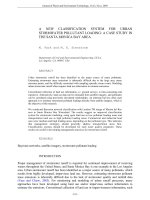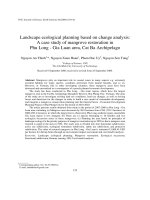Identifying benchmarking for listed enterprises in Vietnam: A case study of listed construction enterprises in Vietnam
Bạn đang xem bản rút gọn của tài liệu. Xem và tải ngay bản đầy đủ của tài liệu tại đây (299.37 KB, 2 trang )
IDENTIFYING BENCHMARKING FOR LISTED ENTERPRISES IN
VIETNAM: A CASE STUDY OF LISTED CONSTRUCTION
ENTERPRISES IN VIETNAM
Nguyen Thi Hong Thuy
Acknowledgements: This study is funded by Project B2017KHA.021
E-mail:,
School of Accounting and Auditing, National Economics University, Vietnam
Do Hong Nhung
E-mail:
School of Banking and Finance, National Economics University, Vietnam
Abstract
For every enterprise, business activities always have hidden opportunities and
risks. One of the biggest risks is bankruptcy. Therefore, how to identify the risk of
bankruptcy and the benchmarking for bankruptcy is an important issue that capture the
interest of enterprises. In this study, besides the determination of the Z-score, Z-score for
bankruptcy risk measurement was determined in accordance with Vietnam's characteristic
market conditions. The score threshold was determined from the Z’’ model using US market
data. This model has been validated in accordance with US market conditions. Through the
assessment of corporate bonds, adjusted for emerging market conditions, national risk
premiums in Vietnam, the Z-score threshold was determined to assess and to give warnings
against the risk of bankruptcy of listed construction enterprises that were researched.
Keywords: Bankruptcy, Z-Score, Benchmarking for bankruptcy.
1. Introduction
The global economy in general and Vietnam‘s economy in particular have been
moving in the cycle of growth - recession - crisis - recovery. Most recently, both the world
and Vietnam suffered from a severe economic crisis starting in 2008. Starting with the US,
the economic crisis rapidly spread to the rest of the world, affecting the global economy.
According to the General Statistics Office, only in the two years 2011 - 2012, Vietnam had
more than 100,000 bankrupt or downgraded businesses1. This led to nearly one million
jobless claims. Only in the first three months of 2013, the Ministry of Planning and
Investment announced that 15,200 businesses went bankrupt or ceased operations, up by
2,200 compared with the statistics of the same period last year2. It could be seen that this
figure was just the tip of the iceberg with the sinking part was hundreds of thousands of
business that ―seemed to be thriving but were actual dead‖, all waiting for bankruptcy. The
cycle of corporate bankruptcy would cripple more businesses. Among them, joint-stock
1
2
National business registration portal dangkykinhdoanh.gov.vn
National business registration portal dangkykinhdoanh.gov.vn
981
5. Conclusion
Bankruptcy was the state of enterprises falling into difficulties or suffering losses in
business activities after employing necessary financial measures but still losing their ability
to pay due debts. There were many reasons for business bankruptcy, including both
subjective and objective ones. One reason was the fluctuation of the economy.
There have been many studies in the world to determine the benchmarking for
bankruptcy. However, they focused mainly on the credit rating model, including the Z
model (Altman (1968)). What they forgot was that this model ws only tested with the data
sets of businesses in the US market. Therefore, in order to apply this model to other
economies, certain adjustments needed to be made. In the Altman‘s (2000) study on
emerging markets, the Z‘‘ model and the Zeta model was approached. The level of credit
ratings was shown to depend on the financial system, the level of risk, as well as
characteristic credit risk of emerging markets, thereby adjusting credit rating, approaching
bond rating and associated Z-score. The underlying foundation of the emerging market
credit rating model (EMS) was the adjustment of Z‘‘ (Altman (1993)), resulting in
emerging market rating and bond rating. Three main factors affecting the outcome of the
model were (1) the depreciation of the currency, (2) sectoral alignment, (3) comparative
advantage. Bond rating was essential to referencing the model. However, no organization
in Vietnam announced the rating of corporate bonds. In addition, the bond market in
Vietnam had many difficulties in the process of formation and development. Thus, US
bond rating was used to adjust for emerging markets and Vietnamese market. In addition,
the comparative advantage of the country was also a problem. In this study the author used
the national risk premium of Aswath Damodaran.
In addition to the aforementioned problems, if the rsearch model of the model were
extended, the result would be better when calculating the Z-score. This was the biggest
limitation of the model and was suggestive for other research in the future.
However, the results of the study insisted that most of the firms in the sample
showed the expected results, which were consistent with the current financial situation
based on liquidity analysis in accoradnce with the financial indicators of these enterprises.
The important thing was that most businesses were in the gray area and there were some
clear manifestations of financial difficulties.
References
1. Altman (1968), Financial ratios, discriminant analysis and the prediction of
corporate bankruptcy, The Journal of Finance 23, 189 – 209, 9/1968.
2. Altman (2005), An emerging market credit scoring system for corporate bonds,
Emering Markets Review 6 (2005) 311-323, Elsevier 9/2005.
3. Altman (2013), Chapter 17: Predicting financial distress of companies:
revisiting the Z-score and ZETA models, Handbook of Research Methods and Applications
in Empirical Finance, Edited by Adrian R.Bell, Chris Brooks and Marcel Prokopczuk.
4. Altman and Hotchkiss (2005), Corporate Financial Distress and Bankruptcy, 3
rd edition, John Wiley and Sons, New York.
5. Aswath
Damodaran
(2017),
/>
992









